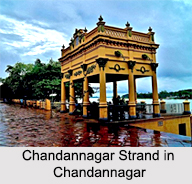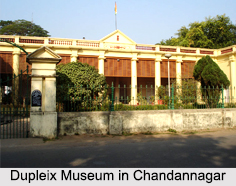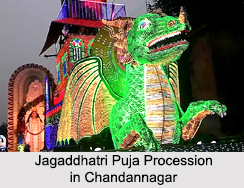 The city of Chandannagar is located about 35 km north of Kolkata and is headquarters of the Chandannagar subdivision of Hooghly district. The city spreads over an area of 19 sq. km. The official languages spoken here are Bengali and English, but since Chandannagar used to be a French colony, the cultural language spoken here is French. The current mayor of this city is Sri Ram Chakraborty.
The city of Chandannagar is located about 35 km north of Kolkata and is headquarters of the Chandannagar subdivision of Hooghly district. The city spreads over an area of 19 sq. km. The official languages spoken here are Bengali and English, but since Chandannagar used to be a French colony, the cultural language spoken here is French. The current mayor of this city is Sri Ram Chakraborty.
Etymology of Chandannagar
The bank of the river Hooghly is crescent shaped like the moon and in Bengali, Chand means moon and Nagar implies city, hence originally the name of the city was actually Chander-Nagar or Chandra Nagar. Another reason behind the name is that the city of Chandannagar used to be a major hub for the trade of Sandal and in Bengali Sandal means chandan. The city also has a temple dedicated to Goddess Chandi, so the origin of the name might also be because of that. But in earlier times, when the city used to be a French colony, before India gained its independence, people knew this place by the name Farasdanga, which means "France donmgi". In Bengali, Farasi means French and danga refers to land. The name Pharasdanga has also appeared in several Bengali literature.
History of Chandannagar
Along the west bank of the Hooghly river there are a string of settlements which formed an exceptional centre of maritime trade with the European powers, the French colonised city of Chandannagar is one of them. The three notable villages of Gondolpara to the South, Boro in the North and Khalisani to the West were incorporated to form the city of Chandannagar. It was formed in the year 1696 and was the second most important French settlement after Puducherry.
Under the governorship of Joseph Francois Dupleix, the city prospered. During his administration more than 2000 brick houses were constructed in the town and with a proliferating maritime trade, people from all across the nation came and settled here for the trade and commerce. The city had thriving centres of trade involving opium, indigo, silk, rice, rope, sugar, etc. From Dupleix"s time to 1756, the city of Chandannagar became the main centre of European commerce in Bengal. The fine clothes from this city were imported to Europe.
In 1757 after the Battle of Plassey, Chandannagar was captured and bombarded by Colonel Robert Clive of the British East India Company and Admiral Charles Watson of the British Navy. And almost a decade later, in 1765, after the Treaty of Paris, Chandannagar was returned to the French but still continued to decline and was eventually overshadowed by the British settlement at Kolkata. After the Indian Independence in 1947, Chandannagar was declared a free city in 1951, when the French officially ceded the city to India. On 2nd October, 1954 Chandannagar was integrated into the state of West Bengal.
 Demographics of Chandannagar
Demographics of Chandannagar
As per the reports of the Census India 2011, the population of Chandannagar is 166,867. Out of which the total number of male and female are 84,009 and 82,858 respectively. The population of children between the ages 0 to 6 years is 11,826. The average literacy of the city is about 90% out of which 92.38% are male and 86.90% are female.
Culture of Chandannagar
The major socio-cultural event in the city of Chandannagar is the Jagaddhatri Puja, which attracts massive crowds from all over the state of West Bengal. Here, the beginning of the puja probably dates back earlier than 1750. The date of the community Jagaddhatri Puja in Chandannagar was 1790. In those days Robert Clive called the place "Loxmigonj "of Chandannagar as the Granary of Bengal. The Jagaddhatri Puja at Chaulpotty, also commonly known as the rice market in Loxmigonj is probably the historic example of the ancient community Jagaddhatri Puja. The festivities bring people together and bridges the past and the present. One of the main attractions of the Jagaddhatri idol of Chandannagar is the ornamental decoration of the Goddess with sola and the beautiful canvas of mats with paintings at the back of the image. It is said that the procession here is the second longest in the world, after Rio de Janeiro"s.
Popular Attractions of Chandannagar
The city of Chandannagar has several places of interest, listed below are a few of them.
Chandannagar Strand: Along the Hooghly river, the tree shaded promenade is about 1 km in length and 7 metres in width. There are many buildings of historical importance along the way, and is a popular place for both local people and tourists. Along the Strand, one can find the Vivekananda Mandir, which is a meditation centre.
 Chandannagar Museum and Institute: Used to be the residence of the former French General, this museum is also known as the Dupleix Palace and is one of the oldest museums in the region. It houses a collection of French antiques like cannons used in Anglo-French war, wooden furniture of the 18th century, etc. This institute still teaches French through regular classes. Apart from French memorabilia, the museum houses rare collections of statues, letters exchanged between freedom fighters, and news clips on the freedom movement in Bengal. With its colonnaded courtyard, broad slatted windows and high ceilings, it is a throwback to period architecture.
Chandannagar Museum and Institute: Used to be the residence of the former French General, this museum is also known as the Dupleix Palace and is one of the oldest museums in the region. It houses a collection of French antiques like cannons used in Anglo-French war, wooden furniture of the 18th century, etc. This institute still teaches French through regular classes. Apart from French memorabilia, the museum houses rare collections of statues, letters exchanged between freedom fighters, and news clips on the freedom movement in Bengal. With its colonnaded courtyard, broad slatted windows and high ceilings, it is a throwback to period architecture.
Sacred Heart Church of Chandannagar: Situated near the Strand, the church was designed by French Architect Jacques Duchatz and was inaugurated in 1884 by a Begian Jesuit priest called Paul Goethals. Still standing majestically for over 200 centuries, the church marks the beauty of the architecture during the French period.
Chandannagar Gate: This Gate was constructed in the year 1937 to mark the Fall of Bastille, a state prison on the east side of Paris which was attacked by an angry and aggressive mob. Etched on the Gate is the slogan of the French Revolution- "Liberty, Equality and Fraternity".
The Underground House: Also known as Patal-Bari, the building is another example of the fine architecture of that period. The lowest floor is submerged in the Ganges River. The Nobel laureate Rabindranath Tagore frequently visited the place and said it influenced him to a large extent and broadened his intellectual capabilities. He mentioned Patal-bari in many of his famous novels.
The other places of attraction in Chandannagar are the Nandadulal Temple, Sabinara Thakurbari, Chandannagar Heritage Musuem, and Radhanath Sikdar Himalayan Museum, etc. Art schools like Rong o Tuli is the most famous art school in town and has been running for over 40 years.
Recently, a heritage conservation and community project has been started here called the Heritage and People of Chandannagar. The main objective is to bring the city on the global platform and draw attention to its conservation and tourism development. An initiative of Aishwarya Tipnis Institute, this project has been supported by the Foundation VMF, a Paris based NGO, along-with the French Heritage in Indian Society, as well as the Embassy of France in India. Workshops and competitions are conducted to encourage active engagement with the settlement and local sites. The Dupleix Museum have been the collaborating partners for the workshops.
Visiting Information on Chandannagar
The city of Chandannagar is about 35 km from Kolkata by roads via the Grand Trunk Road or the Delhi Road. The nearest railway station is Chandannagar station which is connected to the Howrah station located at about 33 km and the Netaji Subhas Chandra Bose International Airport at Kolkata is the closest at a mere distance of about 40 km.



















